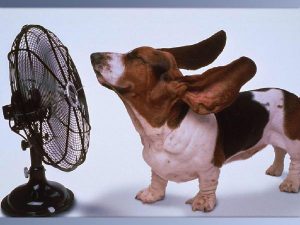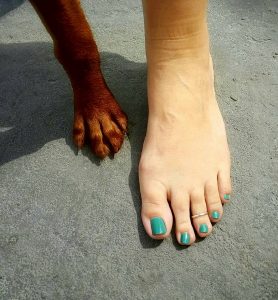It’s  summer…in Tucson. And it is hot. Really hot. Most of us adjust our schedules to accommodate the longer days and heat. We get up early, drink lots of water, use sunscreen, and do our best to stay out of the sun. But did you know dogs are far more vulnerable to the heat than humans?
summer…in Tucson. And it is hot. Really hot. Most of us adjust our schedules to accommodate the longer days and heat. We get up early, drink lots of water, use sunscreen, and do our best to stay out of the sun. But did you know dogs are far more vulnerable to the heat than humans?
Dogs don’t sweat. Or at least they don’t sweat through their skin like we do. They sweat a little through their nose pads and through the eccrine glands around their foot pads, but dogs lower their body temperature primarily by exchanging hot air from their body for cooler air through panting. This works well when ambient temperatures are low, but in the hot desert climate of Tucson where outside temperatures are often equivalent to or higher than body temperature, panting as a means of cooling is very inefficient. This is especially true during the higher humidity accompanying the monsoon season.
Heat Stress and Heat Stroke
Heat stroke is a form of non-fever hyperthermia associated with body temperatures in dogs of 106° or higher. Heat stroke can lead to organ failure and death.
The most important thing to remember about heat stroke is that it is an emergency requiring immediate medical attention.
Symptoms of heat stress and heat stroke
- restlessness
- excessive panting – spatulated tongue
- hyperventilation which may be replaced by shallow breathing as the heat stress progresses
- increased salivation early and then eventual drying of the gums and mucous membranes
- elevated body temperature
- rapid heart rate
- irregular heart beat
- ataxia (wobbly or uncoordinated movement)
- vomiting and diarrhea
- seizures
- shock
- unconsciousness
The normal body temperature for a dog ranges between 99.5 and 102.5. Temperatures are measured rectally in dogs. I recommend having a dedicated thermometer and probe covers as a part of your emergency medical kit for your dog. The normal heart rate for dogs is 60 to 160 beats per minute (bpm). Relaxed, large breed, or athletic dogs tend to have slower heart rates, while small breed dogs and puppies tend to have higher heart rates. This variability in heart rate highlights the importance of knowing what is normal for your individual dog. Respiration rates also vary widely in dogs. Resting rates are usually between 15 and 60 breaths per minute. Ask your veterinarian to teach you how to take your dog’s temperature and pulse. Sit! Stay! Play! will also be offering basic Pet First Aid Classes in the fall.
Panting and a spatulated tongue can be a sign of over-heating
If it is too hot for you to walk barefoot, it is too hot for your dog to be walking on pavement
Causes of heat stroke and heat stress
- excessive ambient heat and humidity
- enclosure in an unventilated room or car
- excessive exercise
 Seasonal heat fluctuations and changes in humidity require time for dogs to acclimatize to the new conditions. Dogs can overheat even when exercising vigorously in water. I think we are all aware of the dangers of leaving dogs in cars, but it is important to remember that cracking a window, even in the shade, will not provide the ventilation necessary to keep your dog safe. Dogs can easily over-heat when the temperature is as low as 65°, especially when exposed to sunlight. Dogs can also over-heat in enclosed rooms like garages and porches. Vets often see problems the first moderately hot days of the summer in active dogs that just go on being really active before they have a chance to get used to the heat.
Seasonal heat fluctuations and changes in humidity require time for dogs to acclimatize to the new conditions. Dogs can overheat even when exercising vigorously in water. I think we are all aware of the dangers of leaving dogs in cars, but it is important to remember that cracking a window, even in the shade, will not provide the ventilation necessary to keep your dog safe. Dogs can easily over-heat when the temperature is as low as 65°, especially when exposed to sunlight. Dogs can also over-heat in enclosed rooms like garages and porches. Vets often see problems the first moderately hot days of the summer in active dogs that just go on being really active before they have a chance to get used to the heat.
Risk factors
- excessive or strenuous exercise

- brachycephalic breeds (short nosed, flat faced breeds) such as pugs, French bulldogs, English bulldogs, Boston terriers, Shih Tzus, Japanese Chins, etc
- large heavy-coated breeds
- obesity
- confinement to paved areas or enclosed spaces
- limited access to water or shade
- heart, lung, or respiratory disease
- dehydration
- hyperthyroidism
What to do
 If your dog is displaying signs of heat stress immediately transfer the dog to a cool environment. Early recognition is the key to recovery. Take the dog’s temperature rectally. If the dog’s temperature is over 103° immediate measures must be taken to lower the dog’s body temperature and get the dog to the vet. Cooling techniques include spraying the dog or immersing the dog in cool, NOT cold, water and wrapping the dog in cool wet towels. Convection and evaporative cooling using fans or by spraying the dog’s groin, pads, or belly with isopropyl alcohol. Allow the dog to drink cool water, but do not force the dog to drink. It is very important to lower the dog’s temperature gradually. Take the dog’s temperature frequently and terminate cooling procedures when the dog’s rectal temperature reaches 103°. Get the dog to the vet immediately.
If your dog is displaying signs of heat stress immediately transfer the dog to a cool environment. Early recognition is the key to recovery. Take the dog’s temperature rectally. If the dog’s temperature is over 103° immediate measures must be taken to lower the dog’s body temperature and get the dog to the vet. Cooling techniques include spraying the dog or immersing the dog in cool, NOT cold, water and wrapping the dog in cool wet towels. Convection and evaporative cooling using fans or by spraying the dog’s groin, pads, or belly with isopropyl alcohol. Allow the dog to drink cool water, but do not force the dog to drink. It is very important to lower the dog’s temperature gradually. Take the dog’s temperature frequently and terminate cooling procedures when the dog’s rectal temperature reaches 103°. Get the dog to the vet immediately.
The vet will determine if there has been any lasting damage to your dog’s brain or organs. Your vet will make certain that your dog’s temperature is stabilized and probably take a blood sample to determine clotting times, take a urine sample to check kidney function, and possibly perform an electrocardiogram to observe any irregularities in heart function. If your dog’s organ functions have been compromised the vet may keep your dog for observation and treatment.
Prevention
Heat stroke can be prevented, but dogs that have experienced hyperthermia are prone to experiencing hyperthermia again. Prevention is the best defense against heat stress.
- Avoid taking your dog out during the hottest part of the day between 10 am and 4 pm
- Make certain your dog has access to plenty of shade and water at all times
- Avoid excessive or strenuous exercise even in moderate heat
- Keep your dog fit and trim
- Consider having your heavy coated dog’s coat thinned or trimmed
- Allow your dog to swim or get wet when outdoors
- Know the signs of heat stress and know what to do in the event of heat stress
- Know your dog’s normal heart rate and pulse rate
- Invest in taking a pet CPR class
Heat related stress is preventable. Know the signs, be smart, and keep your best friend cool and safe. Don’t be tempted to take your dog on a hike in hot weather and if your dog won’t stop chasing the ball even when it is hot, take it indoors! Remember, dogs can over-heat while swimming, so keep an eye on your pup even in the water.
You may find that your dog is damp when picked up at the end of the day at Sit! Stay! Play!. We keep the pools out and the spray bottles ready all day in the summer. All dogs are given plenty of opportunity to rest during the day and relax in the air conditioning from 12 -2! We want our guests to have an enjoyable safe day.


